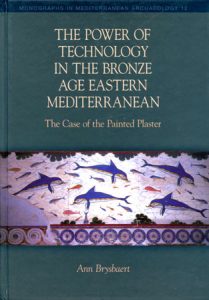ARTICLES | 2008
The distribution of the Late Helladic IIIA-B ivory helmeted heads
Talanta XL-XLI (2008-2009) [2010]: 7-24.
Ivory artifacts, produced by the specialized palatial workshops during the Late Helladic IIIA-B (14th-13th century BC) were found in great numbers and in a variety of areas within the Aegean region. A small group of them consists of representations of the head and neck of male individuals that wear the boar’s tusk helmet. This type of helmet was a popular iconographic motif in the Aegean iconographic repertoire of the Late Bronze Age.Review of Escaping the Labyrinth. The Cretan Neolithic in Context
Aegean Archaeology
Warren, P., 2007-2008. Review of V. Isaakidou and P.D. Tomkins (eds), Escaping the Labyrinth. The Cretan Neolithic in Context (Oxford 2008), Aegean Archaeology 9: 135-139.
Memories of Myrtos
Aegean Archaeology 9, 2007-2008 [2011]: 121-133.
Recently Krzysztof Nowicki, a colleague taking part in an archaeological excavation at Karphi in the mountains of Crete in 2008 directed by his wife, Saro Wallace, made some remarks in an email to my husband, Peter Warren, on running an excavation in Crete.The Late Minoan II goblet: Some aspects of ceramic change at Early Final Palatial Knossos reconsidered
Aegean Archaeology 9, 2007-2008 [2011]: 105-119.
This paper presents a re-reading of previously published evidence from Kastri on Kythera which compels us to reconsider the mechanisms by which Mycenaean ceramic traits such as the goblet spread to Crete. Possible links between Minoan goblets from the final Neopalatial levels at Kastri and a Marine Style goblet from Knossos are examined and the implications of such links for the date of the initial appearance of this shape on Crete are considered. Attention is drawn to the pronounced indigenous character of salient aspects of the Minoan goblet and the Minoan version of the Ephyraean Style.A new look at the Mavrospelio “Kourotrophos”
Aegean Archaeology 9, 2007-2008 [2011]: 91-103.
A small, LM IIB–IIIA terracotta figural group from the Mavrospelio cemetery near Knossos has long been accepted as the one example of kourotrophic iconography from Bronze Age Crete. This figurine shows a skirted female holding aloft a small male by the knees.A view of MM IIIA at Phaistos: Pottery production and consumption at the beginning of the Neopalatial Period
Aegean Archaeology 9, 2007-2008 [2011]: 49-89.
The article investigates aspects of pottery production and consumption at Phaistos during Middle Minoan (MM) IIIA. After the excavations carried out by Pernier and Levi, our knowledge of MM III has seen significant progress over the last decade helping us to look at the role of the palace in this period as well as allowing the ceramic sequence of MM IIIA and MM IIIB to be distinguished. In particular, owing to the rich series of MM IIB and MM IIIA pottery deposits at the site, it is now possible to differentiate on stratigraphic and stylistic grounds an Early from a Mature MM IIIA phase.The Alatzomouri Rock Shelter: Defining EM III in Eastern Crete
Aegean Archaeology 9, 2007-2008 [2011]: 35-48.
A small cave filled with pottery and other Minoan artifacts was discovered by road construction near Pacheia Ammos. The small site, excavated by the 24th Ephorate under the direction of Stavroula Apostolakou, yielded a large assemblage of pottery. The assemblage is of great interest for the stylistic development of East Cretan White-on-Dark Ware because it comes from an early stage in the development when the complicated curvilinear motifs of this style had not yet appeared.
Salvage Excavation in the Cave of Antiparos, Cyclades: Prehistoric Pottery and Miscellaneous Finds. A Preliminary Report
Aegean Archaeology 9, 2007-2008 [2011]: 7-34.
This paper presents the results of a rescue excavation undertaken in the Cave of Antiparos in 2006 that anticipated construction works. This excavation marks the first step towards understanding the general history of the cave' s use. Evidence for the prehistoric use of the cave was found in almost all of the trenches open under disturbed upper layers which contained pottery of the Archaic, Classical and later periods, and modern material.
The Power of Technology in the Bronze Age Eastern Mediterranean. The Case of the Painted Plaster
London

The Archaeology of Tomb A1K1 of Orthi Petra in Eleutherna: The Early Iron Age Pottery
Athens

Μουσείο Μπενάκη, vol. 8 (Benaki Museum)
Athens

